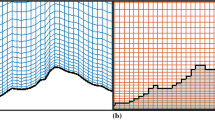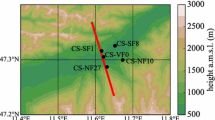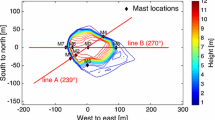Abstract
In Part I the dry version of a new large-eddy simulation (LES) model was presented that is specifically designed to simulate air flow and clouds above highly complex terrain. Here the implemented moisture physics are described and a new method for the generation of turbulent inflow conditions for meteorological LES is proposed. As a typical area of application the new model is applied to simulate banner clouds developing downwind of pyramidal mountain peaks. Banner clouds are shown to be primarily a dynamical phenomenon, and form in the lee of steep mountain peaks as a result of dynamically forced lee upslope flow. Due to the highly asymmetric flow field induced by the extreme orography, banner clouds can form even under horizontally homogeneous initial conditions regarding both moisture and temperature. Thus, additional leeward moisture sources, distinct air masses on both windward and leeward sides, or radiation effects are no prerequisite for banner-cloud formation. The probability of banner-cloud formation increases with increasing obstacle height and steepness and is, to a first approximation, independent of the pyramid’s orientation. Simulations with and without moisture physics reveal that, for the set-up chosen, moisture is of only secondary importance for banner-cloud dynamics. The reinforcement of lee upslope flow and corresponding cloud formation due to latent heat release turns out to be almost negligible. Nevertheless moisture physics are shown to induce a dipole-like structure in the vertical profile of the Brunt-Väisälä frequency, which in turn leads to a moderate increase in leeward turbulence.
Similar content being viewed by others
References
Beer T (1974) Atmospheric waves. Adam Hilger Press, London, 300 pp
Berry EX, Reinhardt RL (1973) Modeling of condensation and collection within clouds. D.R.I. Phys. Sci. Pub. No. 16, University of Nevada, Reno
Bott A (1989) A positive definite advection scheme obtained by nonlinear renormalization of the advective fluxes. Mon Weather Rev 117: 1006–1015
Chaumerliac N, Richard E, Nickerson EC (1987) Sulfur scavenging in a mesoscale model with quasi-spectral microphysics: two-dimensional results for continental and maritime clouds. J Geophys Res 92(D3): 3114–3126
Cohard JM, Pinty JP, Bedos C (1998) Extending Twomey’s analytical estimate of nucleated cloud droplet concentrations from CCN spectra. J Atmos Sci 55: 3348–3357
Deardorff JW (1980) Stratocumulus-capped mixed layers derived from a three-dimensional model. Boundary-Layer Meteorol 18: 495–527
Ding L, Calhoun RJ, Street RL (2003) Numerical simulation of strongly stratified flow over a three-dimensional hill. Boundary-Layer Meteorol 107: 81–114
Douglas C (1928) Some alpine cloud forms. Q J Roy Meteorol Soc 54: 175–178
Durran DR, Klemp JB (1982) On the effects of moisture on the Brunt-Väisälä frequency. J Atmos Sci 39: 2152–2158
Fedorovich E, Nieuwstadt FTM, Kaiser R (2001) Numerical and laboratory study of a horizontally evolving convective boundary layer. Part I: transition regimes and development of the mixed layer. J Atmos Sci 58: 70–86
Fröhlich J (2006) Large eddy simulation turbulenter Strömungen, 1st edn. Teubner, Wiesbaden, 414 pp
Geerts B (1992) The origin of banner clouds: a potential vorticity perspective. In: Bean JR (ed) Sixth conference on mountain meteorology (preprint volume). American Meteorological Society, Portland, pp 97–98. http://www-das.uwyo.edu/~geerts/cwx/notes/chap08/banner.html
Grabowski WW, Smolarkiewicz PK (1996) Two-time-level semi-lagrangian modeling of precipitating clouds. Mon Weather Rev 124: 487–497
Hann J (1896) Allgemeine Erdkunde, 5th edn. Gebrüder Stiepel, Reichenberg, 336 pp
Houze RA (1993) Cloud dynamics, 1st edn. Academic Press, San Diego, 573 pp
Humphreys WJ (1940) Physics of the air, 3rd edn. McGraw-Hill, New York, 676 pp
Hunt JCR, Snyder WH (1980) Experiments on stably and neutrally stratified flow over a model three- dimensional hill. J Fluid Mech 96: 671–704
Ikhwan M, Ruck B (2006) Flow and pressure field characteristics around pyramidal buildings. J Wind Eng Ind Aerodyn 94(10): 745–765
Kataoka H, Mizuno M (2002) Numerical flow computation around aeroelastic 3D square cylinder using inflow turbulence. Wind Struct 5: 379–392
Klemp JB, Lilly DK (1978) Numerical simulation of hydrostatic mountain waves. J Atmos Sci 35: 78–107
Lund TS, Wu XW, Squires KD (1998) Generation of turbulent inflow data for spatially-developing boundary layer simulations. J Comput Phys 140: 233–258
Martinuzzi RJ, AbuOmar M (2003) Study of the flow around surface-mounted pyramids. Exp Fluids 34: 379–389
Mason PJ (1989) Large-eddy simulation of the convective atmospheric boundary layer. J Atmos Sci 46(11): 1492–1516
Mayor SD, Spalart PR, Tripoli GJ (2002) Application of a perturbation recycling method in the large-eddy simulation of a mesoscale convective internal boundary layer. J Atmos Sci 59: 2385–2395
Nickerson EC, Richard E, Rosset R, Smith DR (1986) The numerical simulation of clouds, rain, and airflow over the Vosges and Black Forest mountains: a meso-β model with parameterized microphysics. Mon Weather Rev 114: 398–414
Reinert D (2009) Dynamik orographischer Bannerwolken. PhD thesis, Johannes Gutenberg-University, Mainz, 171. http://www.uni-mainz.de/FB/Physik/IPA/forschung/publikationen/PDF/dissertation_danielreinert.pdf
Reinert D, Wirth V, Eichhorn J, Panhans WG (2007) A new LES model for simulating air flow and warm clouds above highly complex terrain. Part I: the dry model. Boundary-Layer Meteorol 125: 109–132
Schween J, Kuettner J, Reinert D, Reuder J, Wirth V (2007) Definition of ‘banner clouds’ based on time lapse movies. Atmos Chem Phys 7: 2047–2055
Smolarkiewicz PK, Grabowski WW (1990) The multidimensional positive definite advection transport algorithm: nonoscillatory option. J Comput Phys 86: 355–375
Smolarkiewicz PK, Rotunno R (1989) Low froude number flow past three-dimensional obstacles. Part I: baroclinically generated lee vortices. J Atmos Sci 46: 1154–1164
Trautmann T (1997) The interaction of radiation with cloud microphysics in the marine boundary layer. Habilitation thesis, Institute for Atmospheric Physics, University of Mainz, 262 pp
Author information
Authors and Affiliations
Corresponding author
Rights and permissions
About this article
Cite this article
Reinert, D., Wirth, V. A New Large-Eddy Simulation Model for Simulating Air Flow and Warm Clouds Above Highly Complex Terrain. Part II: The Moist Model and its Application to Banner Clouds. Boundary-Layer Meteorol 133, 113–136 (2009). https://doi.org/10.1007/s10546-009-9419-x
Received:
Accepted:
Published:
Issue Date:
DOI: https://doi.org/10.1007/s10546-009-9419-x




